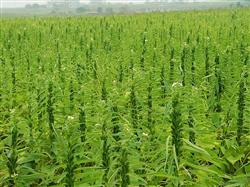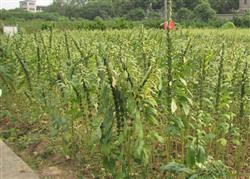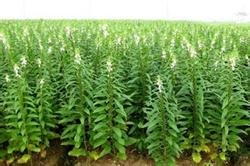Key points of cultivation and management of sesame

Sesame is one of the main cash crops and has a high reputation in the international and domestic market. the main points of high-yield cultivation techniques of sesame are introduced as follows: first, soil preparation and fertilization should be used in time after the previous crop harvest. 3000 kg of farm manure per mu, 10 kg of standard nitrogen fertilizer, 30 kg of superphosphate and 10 kg of potassium sulfate. It is appropriate to turn 15 cm to 20 cm deep, and rake flat and fine. Second, before seed dressing and sowing, use 5 grams of carbendazim wettable powder or 40% carbendazim gel suspension per mu, add water to make a paste, mix well with seeds, dry and sow seeds. Third, timely sowing sesame seeds should be sown before the end of June, with a seed amount of 500 grams per mu. Sesame seeds should be sown with sufficient moisture, and those with insufficient moisture should be sowed. Sesame must avoid repeated cropping, sesame continuous cropping, the plant is short, the capsule is reduced, the disease is aggravated, and the yield is very low. therefore, the four-year two-head rotation system is generally advocated. After sowing sesame seeds should be pressurized properly in time to improve the ability of preserving soil moisture and conducive to seedling emergence. 4. Meticulous management. 1. Check seedlings and replenish seedlings. After sesame emergence, if there is a lack of seedlings, it is necessary to replant or replenish seedlings in time. 2. Ploughing and weeding. When the first pair of true leaves appear, the first intertillage should be carried out at a shallow depth; when 2 or 3 pairs of true leaves are grown, the second intertillage should be carried out; when the first branch is just branched, the third intertillage should be carried out; in the later stage of flowering, shallow and middle ploughing should be carried out. 3. The seedlings are fixed. When the first pair of true leaves appeared, the seedlings were carried out, and when 2-3 pairs of true leaves were grown, the seedlings were fixed. There are about 14000 seedlings per mu, with row spacing of 47 cm and plant spacing of 10 cm. 4. Rational fertilization. On the basis of sufficient basal fertilizer, when the sesame seedling is 33 cm high, it is combined with fertilization to cultivate soil. 1015kg urea per mu was topdressing at the beginning of flowering, and 0.3% potassium dihydrogen phosphate solution was used for foliar spraying twice at the later stage of full flowering. 5. Suitable for watering. Sesame is a non-waterlogging-resistant crop, which is generally not watered as long as the soil moisture is good at the seedling stage. Flowering and capsule period, if the rainfall is sufficient, do not water, and pay attention to drainage, if the weather is dry, water should be properly watered. During the capping period, if there is little rain in autumn, it should be watered to make the seeds full and increase the yield. 6. Control prosperity and prevent decline. If sesame has a trend of prosperous growth, spray 50 kg of water with 2.5 grams of metoprolol or zhuangsu per mu during flowering. 7. Disease and pest control. Spraying leaves with 1000 times of hydantoin or 50% methyl topiramate at jointing stage to control sesame horn blight or leaf blight; ground tigers can be sprayed with 2.5% enemy kill or 20% trimethoprim 1000 times before the 3rd instar; after the third instar, the ground tigers can be trapped and killed by cottonseed cake or wheat bran mixed with poison bait, or artificially killed; aphids can be controlled by 1000 times omethoate. 8. Topping to promote ripening. When the lower capsule is nearly mature, the upper part of the sesame which is still blooming is removed by hand or scissors from the end of July to the middle of August to concentrate nutrients on the formed capsule, which is beneficial to early maturation and improve yield and quality. Fifth, timely harvest when the final flower of sesame is about 20 days, most of the leaves are withered and yellow, the peeling leaves are 2 or more, the capsule is yellowish brown, the lower part has been cracked, the upper capsule is yellowish green, still closed, shake the lower part by hand, the capsule has a sound, when the seeds show inherent color, harvest, and try to harvest before the early frost.
- Prev

How to fertilize sesame seeds
Sesame, also known as oil, is rich in protein and a variety of vitamins and iron, calcium, sesame phenols and other substances, rich nutrition, rich aroma, is an indispensable ingredient for the production of pastries and characteristic food. Sesame oil is a rare excellent edible oil. Sesame is a temperature-loving crop, and July is the best time for autumn sowing of sesame. Zhi.
- Next

Why are sesame seeds afraid of repeating?
First, it is expensive to hit the top at the right time. Usually spring sesame retains the first pair of true leaves and summer sesame retains the second pair of true leaves. The experiment shows that this is the best time to top, and the induction rate of double stems is up to 100%. The specific time is: spring sesame in the second pair of true leaves half unfold, summer sesame in the third pair of true leaves half unfold, during which about a week.
Related
- The first cup of black tea in spring, the flavor and history of tea gardens in Kenya, Africa
- The computer can not only choose potatoes, but also grow tea rice. AI will grow winter oolong tea champion.
- It is not only the inflated tea bitten by insects, but also engraved with the four seasons tea in Beipu.
- The Oriental Beauty Tea Festival in Zhuxian County takes the stage at the weekend to experience the plus-size feast of oil tea.
- & quot; Oriental Beauty Tea & Exploration of Emei in Hsinchu, the hometown of quot;
- The new variety of strawberry "Tainong 1" dessert is the first choice with mellow aroma. Crimson gorgeous
- History of Tea in Taiwan: from Wild Inner Mountain to Export Tea Garden
- Two types of Taiwan Oriental Beauty Black Tea won the British three-Star Award for Childhood Tea Xiang Zhang Jiaqi changed from pilot to champion tea maker.
- Banana species and varieties: the planting history of Taiwan Xianren banana and dwarf banana is long, is banana disease resistant?
- Coffee planting Technology: Qianjie Coffee from Seedling to harvesting

